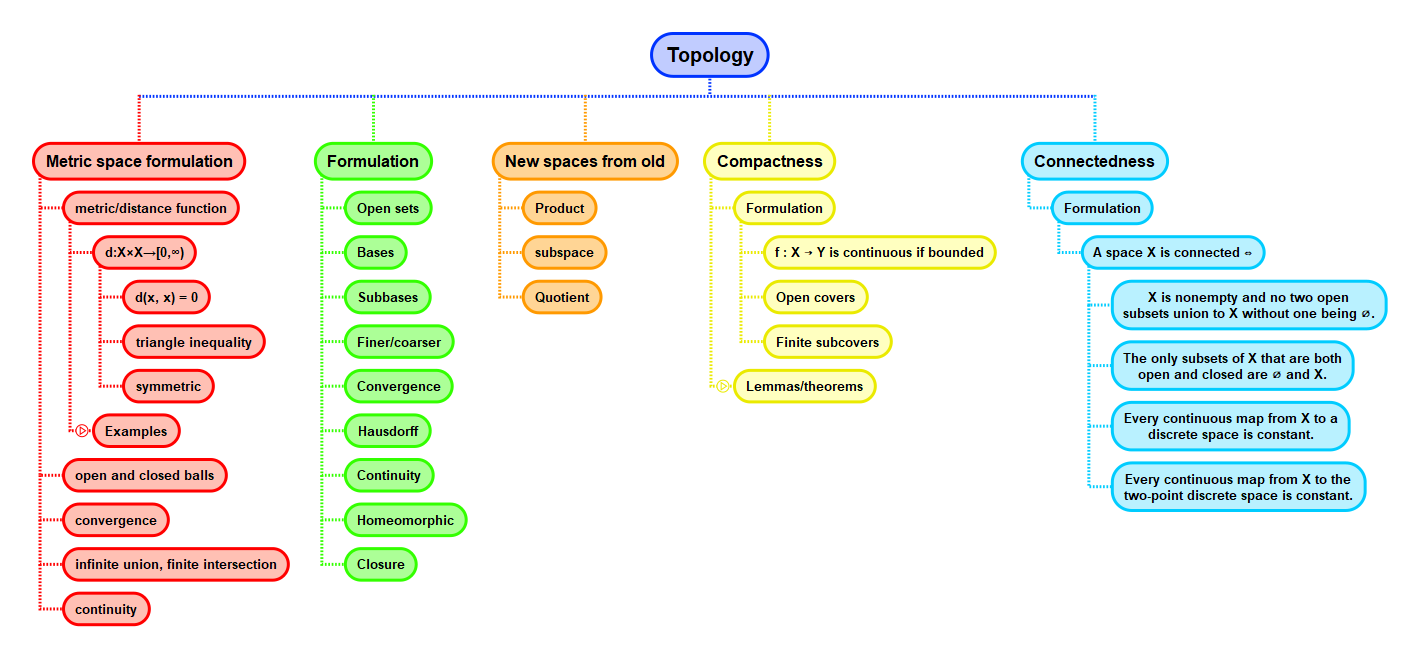Connectedness. Definition
Connectedness
Let \( X \) be a topological space. A separation of \( X \) is a pair \( U, V \) of disjoint nonempty open subsets of \( X \) whose union is \( X \). The space \( X \) is said to be connected iff there does not exist a separation of \( X \).
This definition is from Munkres. Leinster's definition feels a little less intuitively concrete.
Connectedness, formulation 2 (or now a lemma)
A space \( X \) is connected iff the only subsets of \( X \) that are both open and closed in \( X \) are the empty set and \( X \) itself.
Again, from Munkres.
Connectedness, motivation
Focus on two sets that union to create the set in question: if two sets union to the whole but are not "touching", then the set in question is disconnected. Intuitively, a space is said to be 'connected' if it is all in one piece—it does not fall naturally into two or more pieces. 'Naturally' here carries a major component of the sense of 'connected', as any topological space can be torn into multiple pieces in some way.
Disconnected
The idea of a set being disconnected is possibly more intuitive than the idea of a set being connected. In \( \mathbb{R} \), a set \( E \subseteq \mathbb{R} \) is disconnected if it can be expressed as the union of two separated sets. Separated here means that the sets share no limit points (\( A \) and \( B \) are separated if \( \overline{A} \cap B \) and \( A \cap \overline{B} \) are empty). In other words, one can't find a sequence in \( A \) whose limit is in \( B \) and vise versa.
Yet another formulation is to say that \( E \subseteq \mathbb{R} \) is disconnected iff for some \( a, b \in E \) there is a \( c \in \mathbb{R} \) but not in \( E \) such that \( a < c < b\). Push a negation into this statement to get back to the connected version: \( E \) is connected iff for all \( a, b \in E \), whenever \( a < c < b \) for some \( c \in \mathbb{R} \), then \( c \in E \).
Tearing
Intuitively, why can't the real line \( \mathbb{R} \) be separated naturally into two pieces? Consider the decomposition \( (-\infty, 0) \cup [0, \infty) \): in what way is this separation not natural? While it might not appeal to everyone's intuition, this separation is considered forced because a limit point of \( (-\infty, 0) \), zero, is not an element of \( (-\infty, 0) \) but an element of the other piece \( [0, \infty) \). In other words, the closure of one piece spills into or is contained or is intertwined in the other piece. Thus, naturally separating a space can be viewed from the lens of open and closed sets.
Natural separation, requirements
For a topological space \( X \), a separation of \( X \) into disjoint subsets is considered a natural separation into independent pieces \( U \) and \( V \) if no point in \( U \) is a limit point of \( V \), and vice versa. Equivalently, this means that \( Cl(U) \) is disjoin from \( V \), and vice versa, or equivalently, that both \( U \) and \( V \) are closed, or equivalently yet again, that both \( U \) and \( V \) are open.
Thus, we arrive at our definition of connectedness, by defining a space \( X \) connected if the only natural separation of \( X \) as described above is the trivial one, \( \emptyset \) and \( X \) itself.
Sufficiency of open sets
If disjoint open sets are sufficient to cover a space, then the space is not connected. Open sets don't contain their boundary limits, and two disjoint open sets must therefore not be touching. There is at least a point that exists in the sense of limits that is in neither of the open sets. In this sense, the space is disconnected.
Context

